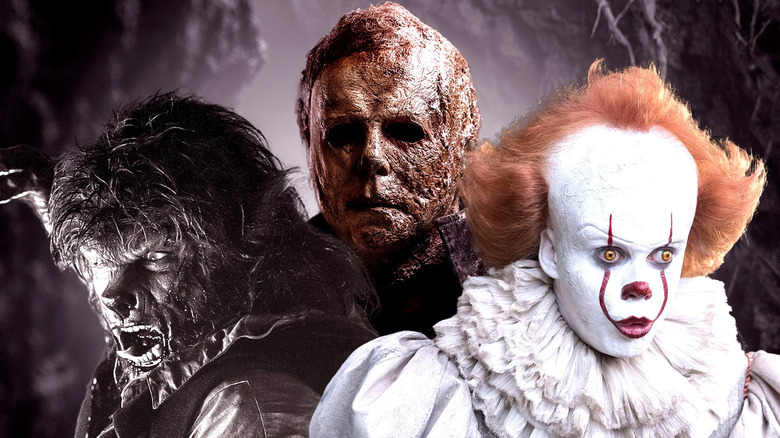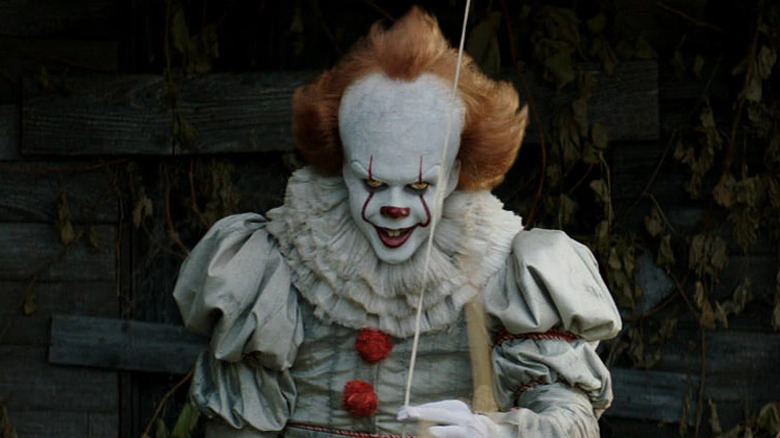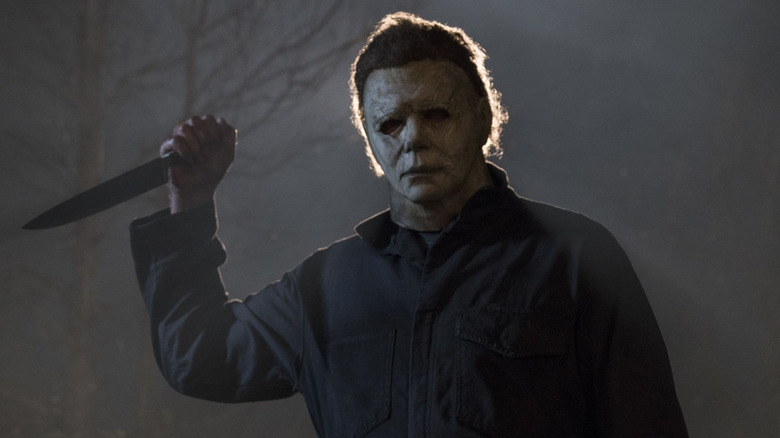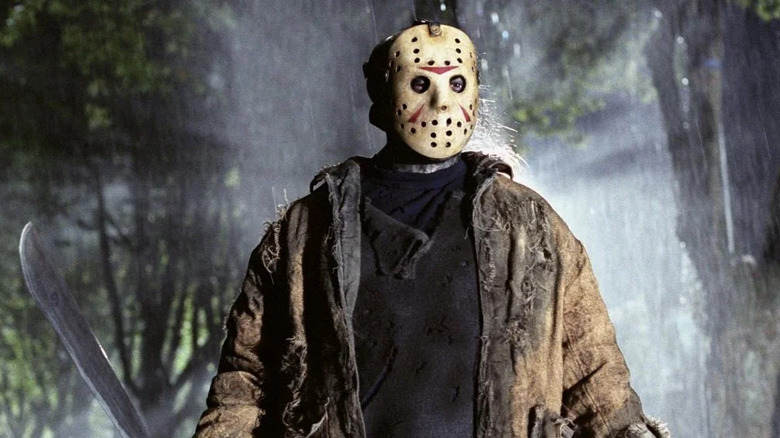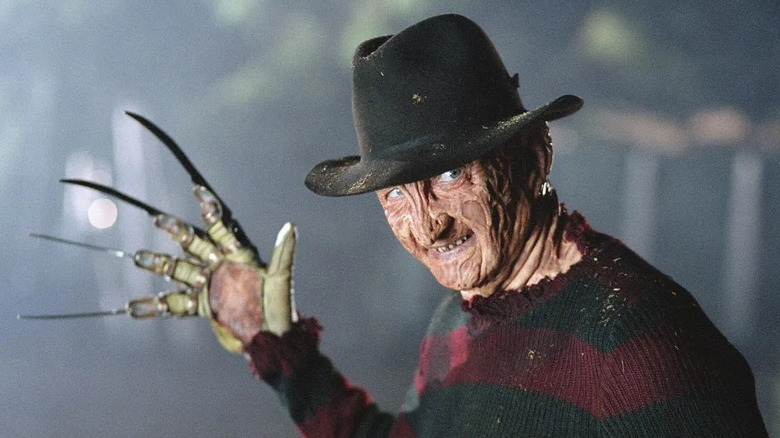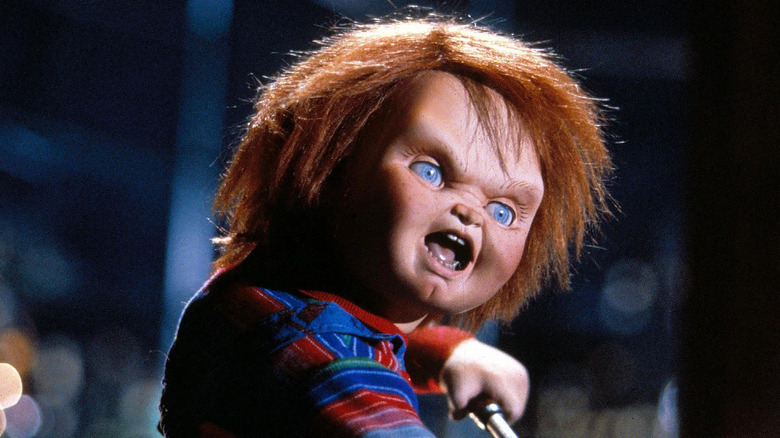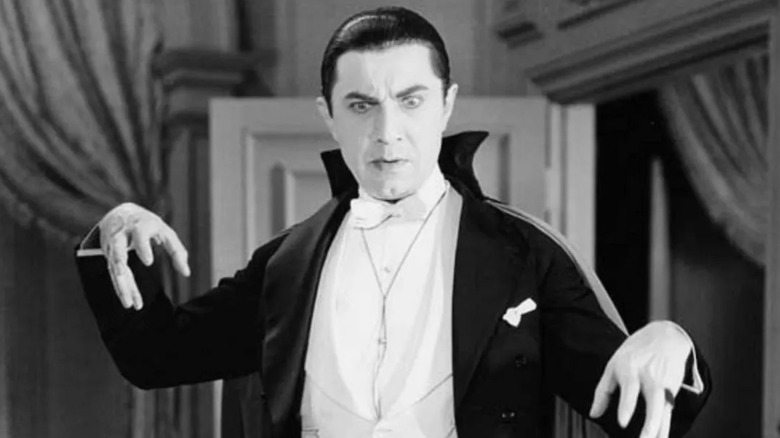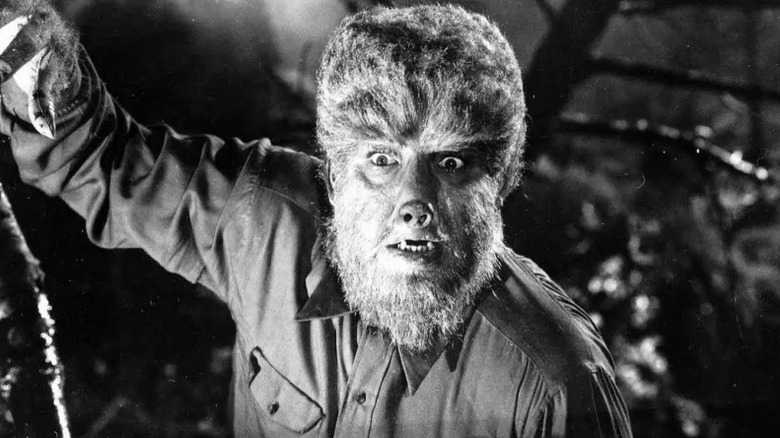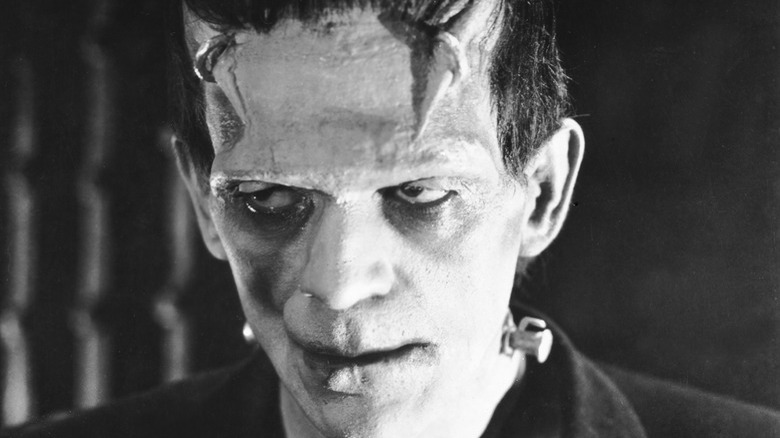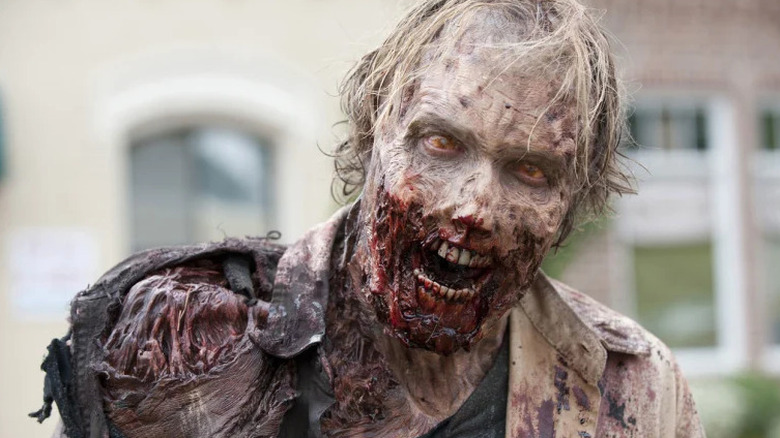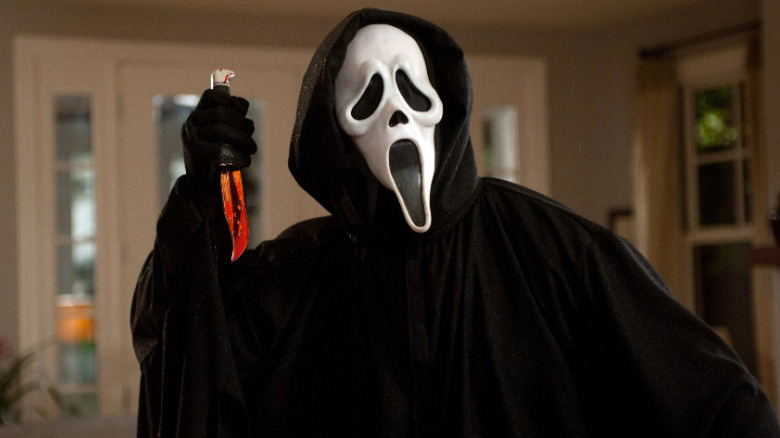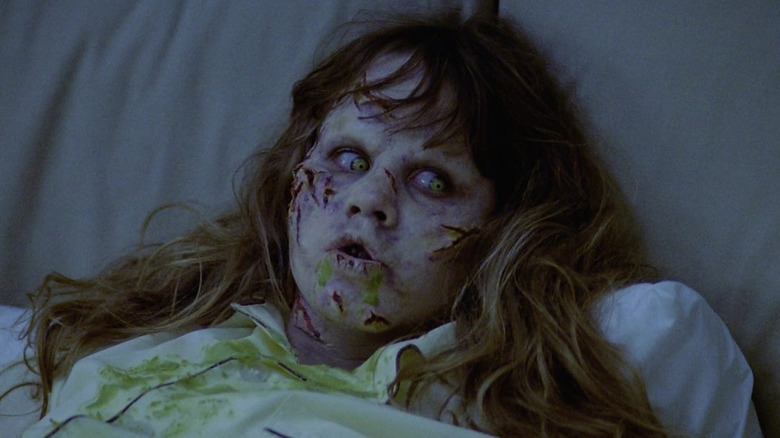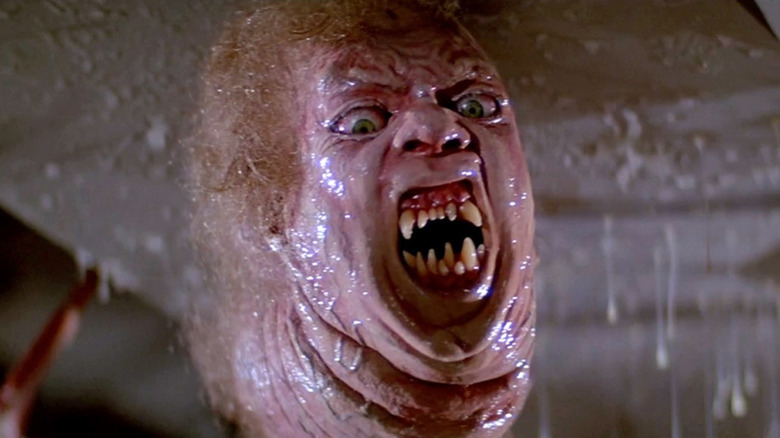The Biggest Weakness From Famous Horror Movie Villains Explained
Horror movies wouldn't be the same without terrifying villains wreaking havoc on the main characters. Whether there's an evil spirit trying to possess someone's body or a deranged serial killer terrorizing a group of teenagers, audiences love getting scared by horror movie villains. Of course, it wouldn't be any fun if the heroes beat the antagonist without breaking a sweat, so the best villains are the toughest ones to beat. Some have superhuman strength and speed, while others use demonic powers to trap and kill their victims — and to make things even harder, they usually can't be stopped with a simple gunshot or knife wound.
But despite all their strengths, even the most powerful villains have their weaknesses. From something as simple as exposing them to sunlight to figuring out how to complete a complicated ancient ritual, there are certain ways to overpower and defeat them. Keep reading to find out famous horror movie villains' greatest weaknesses so you know how to beat them if you ever go up against them.
Pennywise
Stephen King's "It" has scared audiences across generations. Originally released as a novel in 1986, the story has since been adapted into a TV miniseries and a two-part film. The terrifying monster known as It is a multi-dimensional being that can shapeshift and alter reality. It feeds off the fear of its victims, which is why It predominantly takes the form of Pennywise the Dancing Clown. Clowns are widely feared among children and adults alike, making this the most useful form for It to use.
Although It is a powerful entity, the Losers Club eventually discovers that Pennywise's biggest weakness is teamwork. When they work together to perform the Ritual of Chüd in 2019's "It Chapter Two," they're almost able to defeat Pennywise (Bill Skarsgård), but things go wrong. Part of the reason the ritual fails is that they all stop chanting together, and on top of that, they aren't courageous enough. The Losers have to be courageous and believe that they can win, otherwise, Pennywise is able to overpower them.
Pennywise has several other weaknesses as well. No matter what shape it assumes, the villain has to follow the laws of nature; so when Pennywise morphs into a werewolf in the TV adaptation, the Losers can hurt it with silver, and so on. Pennywise is also at a disadvantage since it only terrorizes the town of Derry and hibernates for 27 years between each killing spree, allowing the Losers to come up with a plan.
Michael Myers
Michael Myers seems nearly invincible as he stalks and murders people throughout the "Halloween" franchise. He's eerily quiet, always wears a mask, and walks instead of running toward his victims. After murdering his sister when he was little, he spent 15 years in a mental hospital, then broke out to kill his remaining family members. So how did a mere human become such an unstoppable force? In the sixth film of the franchise, 1995's "Halloween: The Curse of Michael Myers," it's revealed that Dr. Wynn (Mitchell Ryan) placed the Curse of Thorn on Michael, making him much more powerful and resilient to harm, while also driving him to murder his relatives every year on Halloween.
Therein lies his biggest weakness: Michael only goes on killing rampages around Halloween, so he's very predictable. His victims only have to avoid him for one night, and they have the rest of the year to plan how to do that, potentially giving them the upper hand. Plus, he only targets his family members and those associated with them. As long as you avoid anyone related to Michael around Halloween every year, you can steer clear of him.
Jason Voorhees
Jason Voorhees is a ruthless serial killer who mainly appears in the "Friday the 13th" franchise, but has also been featured in video games like "Mortal Kombat X" and the 2003 crossover movie, "Freddy vs. Jason." Instantly recognizable by his hockey mask, Jason predominantly uses a machete to slaughter his victims.
Jason goes on several homicidal rampages until he is killed in the fifth film of the franchise, 1985's "Friday the 13th: A New Beginning." Then he is accidentally brought back to life in "Friday the 13th Part VI: Jason Lives" when Tommy (Thom Mathews) stabs his body with a metal pole and it gets struck by lightning. After that, Jason becomes much stronger and is unfazed by serious injuries that would kill a normal person, making him much harder to defeat.
That said, Jason's main weakness is water due to nearly drowning in Crystal Lake when he was 11 years old. He has been afraid of water ever since that incident — a fear that Freddy Krueger discovers and exploits when they fight each other. Jason also cares deeply for his late mother, Pamela, so if you disguise yourself as her, you might be able to manipulate and control him. Alternatively, you could fend him off with regular weapons for long enough to escape from Camp Crystal Lake since he tends to stay in that area.
Freddy Krueger
Freddy Krueger is a child murderer who is burned to death, then returns as an evil spirit that kills people in their nightmares, which also kills them in real life. Throughout the "A Nightmare on Elm Street" franchise, he mostly murders the teenage descendants of those who killed him, but he has targeted others. He's extremely powerful in the dream realm, with the ability to shapeshift, heal, and alter the appearance of the dream world. His weapon of choice is a clawed glove that he uses to slice his victims.
So how can Freddy be defeated? If enough people forget about him, he will be trapped in Hell and won't be able to hurt anyone, making this his biggest weakness. Since he mostly attacks people while they're dreaming, he has a few other vulnerabilities as well. If his victims learn how to lucid dream, they can control it and either attack him or wake themselves up. He's afraid of fire since he was burned to death, so learning how to lucid dream and then trapping him in a burning building would be a smart plan.
In the 1984 original, Nancy (Heather Langenkamp) learns that fear makes Freddy (Robert Englund) stronger, so it's best to be courageous while facing off against him. She also figures out a way to bring him into the real world, where he's vulnerable to the same things as a regular human — but hurting him in the real world won't destroy him for good.
Chucky
Chucky is a psychotic, evil doll who kills countless victims in the "Child's Play" franchise, but he actually used to be human. He was a serial killer back then too, but after getting shot during a police chase, he used black magic to transfer his soul into the doll. This allows him to continue tormenting others while he tries to find a human host to transfer his soul. On top of being as strong and fast as a full-grown adult, he knows voodoo and can pretend to be a regular doll until the time is right, so he's tough to beat.
Although Chucky's doll body gives him some advantages, it's actually his greatest weakness as well. The longer his soul is trapped inside the doll, the more it takes on characteristics of a human body, making him vulnerable to the same wounds as a regular person. That means he can be fatally wounded by being shot, dismembered, burned, etc.
From there, his soul will try to possess a new vessel, but that gives you time to escape. He can only take over Good Guy dolls, so avoid anyone who owns one, toy stores, and Good Guy factories, and you should be good. If you do run into Chucky again, you might be able to overpower him due to his small size. He's as strong as an adult, but he doesn't have superhuman strength, so someone strong enough could toss or kick him around during a fight.
Dracula
Count Dracula is one of the most iconic horror villains of all time. The bloodthirsty vampire first appeared in Bram Stoker's 1897 novel, "Dracula," and since then, he has been featured in many different movies and TV shows. His abilities vary depending on the adaptation, but essentially he feeds off his victims' blood and turns them into vampires. He's extremely difficult to defeat since he has superhuman strength and agility, hypnotic powers, and the ability to shapeshift (most commonly into a bat), plus he's unharmed by most physical attacks and can't die from aging.
Despite all of his strengths, he has several weaknesses – most notably, sunlight. In the original novel, sunlight significantly weakens his powers, but this was changed in later adaptations so that sunlight burns and kills him. If you're nowhere near a window while trying to take down the Count, you can kill him by stabbing a stake through his heart instead. He's also disgusted by garlic and religious items, such as crosses, holy water, and sacramental bread, so those can be used to keep him away while you come up with a plan.
Werewolves
"The Wolf Man" was released back in 1941 and is still one of the best werewolf movies ever made. The film centers around a man (Lon Chaney Jr.) who gets bitten by a werewolf, causing him to turn into one as well. He has no control over when he transforms into a werewolf, and whenever it happens, he goes on a killing rampage that he can't remember afterward.
Werewolves have different abilities depending on the adaptation, but they're often depicted as strong, agile, resilient to most injuries, and able to heal quickly. In some cases, they can choose when they transform and they even have control over themselves while in werewolf form, but other times, they automatically transform during the full moon and become uncontrollably violent.
They're weak against any object made of silver; even touching silver can hurt them. Most famously, they can be taken down with a silver bullet, but the werewolf in "The Wolf Man" is killed by a blow to the head with a silver-tipped cane. If you don't have access to silver while facing off against a werewolf, you could wait to attack them until they turn back into a human since they'd be susceptible to the same things as a normal person.
Frankenstein's monster
In Mary Shelley's 1818 novel, "Frankenstein," a scientist named Victor Frankenstein uses bits and pieces of corpses to create a horrifying, highly intelligent creature. Frankenstein instantly regrets what he has done and abandons the monster, who becomes filled with hatred after being treated cruelly by everyone he encounters. The monster is about eight feet tall, possesses great strength, stamina, and speed, and can endure harsh conditions like frigid temperatures, making him a very formidable opponent. He has appeared in several TV and movie adaptations over the years, overpowering and murdering numerous victims while exacting his revenge on Frankenstein.
Although the monster can withstand extreme temperatures to a certain point, his biggest weakness is fire. At the end of the novel, he makes a speech about how he plans to commit suicide: "Soon these burning miseries will be extinct. I shall ascend my funeral pile triumphantly and exult in the agony of the torturing flames. The light of that conflagration will fade away; my ashes will be swept into the sea by the winds." In the 1931 film, the creature is noticeably afraid of fire, and a group of villagers defeats him by setting a windmill ablaze while he's trapped inside.
Zombies
Although the 1968 film, "Night of the Living Dead," wasn't the first zombie movie ever made, it helped bring zombies into mainstream media and set the stage for countless other shows, movies, and video games. In the film, the undead rises from their graves and begin viciously attacking people, eating their flesh, and turning them into zombies. Since they're already dead, they can endure injuries that would kill a regular person like being stabbed or shot in the chest. The only way to kill a zombie once and for all is to deal a sufficient amount of damage to their head (according to Hollywood). Whether you use a gun, blunt object, bow and arrow, fire, or even your bare hands, you just have to make sure to destroy the zombie's brain.
If that's not possible, you can take advantage of some of their other weaknesses instead. Zombies are often depicted as unintelligent, uncoordinated, and slow, so they can be outsmarted or outran if that's the case. It's also best to avoid urban areas that were heavily populated before the outbreak since zombies are stronger in large numbers. Shows like "The Walking Dead" and "The Last of Us" have shown us that it's much easier to kill zombies one at a time rather than trying to take down an entire horde at once.
Ghostface
"Do you like scary movies?" Since Ghostface asked one of their first victims that question in the opening scene of "Scream" in 1996, the deranged killer has gone on to torment countless teens. Ghostface isn't just one person, though, but an identity that various people have used during their killing sprees throughout the franchise. That makes them hard to catch since they wear a mask and use voice changers to conceal their true identity. Even if the protagonist survives long enough to defeat the killer — or killers — using the Ghostface identity in one movie, someone else will take up the mantle next time around.
Even though Ghostface is virtually impossible to defeat in the long run, they still have many weaknesses. Their biggest downfall is that they need to keep their true identity hidden so they can have the upper hand and avoid the police. Once Ghostface's identity is revealed, things tend to go south for them. Having lost their disguise and the element of surprise, they continue fighting to carry out their scheme, but can easily be killed via gunshot, knife wound, or a large TV falling on their head. The possibilities are endless.
The demon from The Exorcist
When the demon Pazuzu possesses 12-year-old Regan (Linda Blair) in the 1973 film, "The Exorcist," she becomes stronger, extremely violent, and able to do creepy things like speak in tongues and turn her head completely around. Understandably, her mother (Ellen Burstyn) is concerned and enlists the help of two Catholic priests. Pazuzu verbally attacks the priests while they try performing an exorcism, causing Father Kerras (Jason Miller) to question his faith at one point. It proves to be very difficult to defeat the demon since the priests want to destroy it without killing Regan.
Although the exorcism goes awry in the first movie, subsequent films in the franchise show that a properly executed exorcism — done by a priest with strong faith — is the demon's greatest weakness. This will save the possessed person by driving Pazuzu out of their body, and from there it will need to possess another host to cause any real harm. To avoid getting possessed, the characters have to avoid cursed items, ouija boards, or wear St. Joseph's medallion for protection. If someone does end up getting possessed and an exorcism can't be done, the demon can be hurt with holy water or forced out of the host's body upon their death.
The Thing
In 1982's "The Thing," researchers in Antarctica are terrorized by an alien that can disguise itself as other organisms, including people and dogs. The Thing's shapeshifting abilities are so convincing that it can imitate various members of the group at the same time, looking and behaving just like them as it waits to attack its next victim. If someone manages to figure out that their friend has been killed and replaced by the Thing, it gives up the charade and morphs into different forms that are just as strong as they are grotesque. You can shoot it, hit it over the head, and even decapitate it, but its cells will still be alive, allowing the Thing to regenerate and take over a new host.
While the alien can't be defeated with most weapons, it can be killed with fire, making that its biggest weakness by far. In the 1982 film and its 2011 prequel, the characters use flamethrowers to torch the Thing. Its vulnerability to fire means that characters can also use grenades and dynamite against it, although this method seems less effective since the Thing will live on if even one of its cells survives the explosion.
In the 1951 film, "The Thing From Another World," the alien is actually destroyed via electrocution, revealing another one of its weaknesses. If you're unable to electrocute or incinerate the Thing, it can be frozen and put into hibernation instead — just make sure no researchers thaw it out later.
